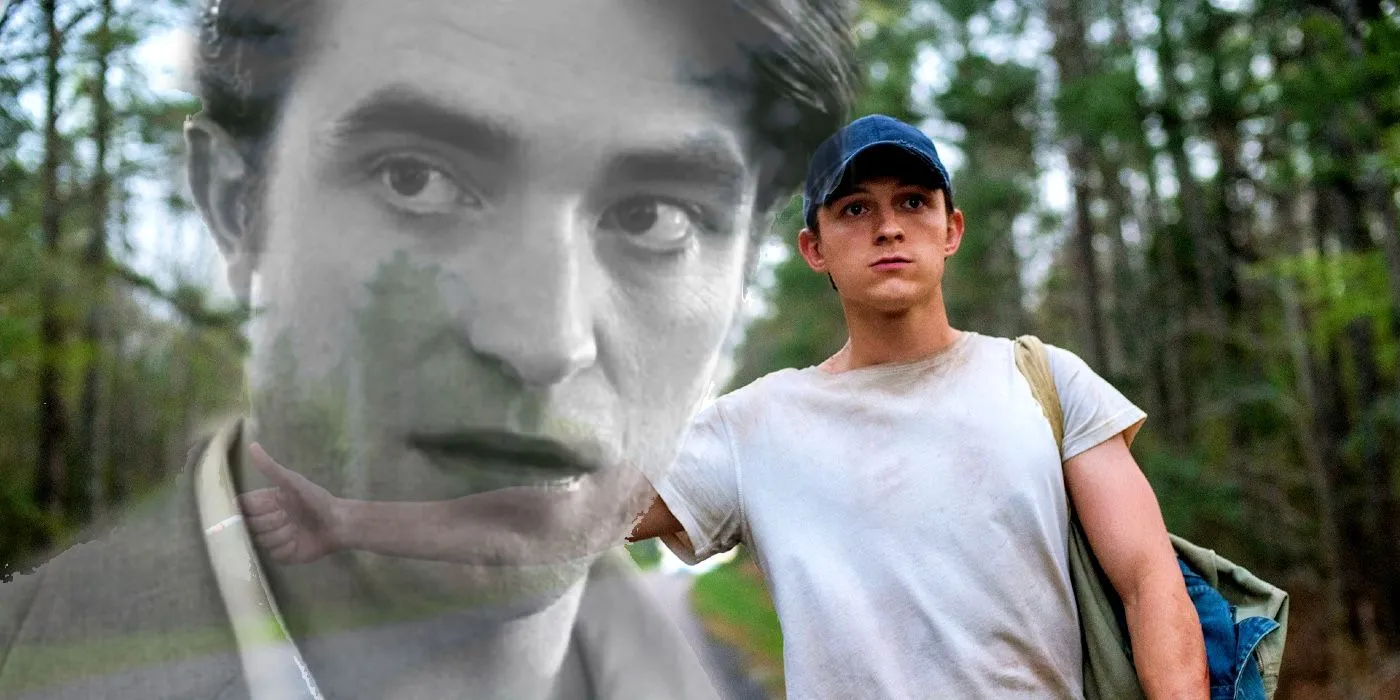Rather than start as a thriller, The Devil All The Time brings forward issues surrounding violence, inherited trauma, blind faith, and murder within a rural American setting. Even though the ending might appear direct on the surface, the film encourages a deeper look at the themes it touches and what message lies beneath it all.
This movie is based on Donald Ray Pollock’s 2011 book with the same title. The story moves at a calm, steady pace and focuses more on character development than fast action—similar to some of Stephen King’s stories that lean less on the supernatural, like The Green Mile or The Shawshank Redemption.

A large cast made up of well-known Hollywood actors—Robert Pattinson, Tom Holland, Sebastian Stan, Riley Keough, Bill Skarsgård, Jason Clarke, and Mia Wasikowska—strengthens the ensemble. Pollock’s writing joins different tales that are all centered around Knockemstiff, a real town in Ohio.
After World War II, the town becomes the backdrop for hidden problems and disturbing secrets, especially when a questionable preacher arrives to take control of the local church. The story is told using two timelines that follow the life of Arvin Russell.
As a child (played by Michael Banks Repeta), he goes through serious trauma after his mother, Charlotte (Haley Bennett), dies, and he watches his father, Willard (Skarsgård), turn to religious devotion in a desperate attempt to cope.
Willard himself had been haunted by a horrific wartime experience, and when he came back home, it was like he returned carrying heavy spiritual baggage. His mental state worsens as his wife’s illness grows, leading him to make a desperate sacrifice that could either be viewed as an attempt to bargain for her life or a tragic end to his suffering.
Later, as an adult (played by Tom Holland), Arvin becomes a type of vigilante, trying to clean up the town from evil influences, even as he continues battling with his emotional wounds.
The story is told with enough care to avoid confusion, but it leaves plenty of room for the audience to think about the deeper motivations behind each character’s decisions.
What Exactly Was Wrong With Willard (Was It Possession?)
When Willard Russell returns to his life in Knockemstiff after serving in the war, he tries to adjust and find stability. One of the things that deeply affected him during his time in combat was witnessing a man strung up like someone being crucified—a disturbing image that likely made him begin to question his beliefs.
His curiosity and dependence on faith grew worse when he saw a preacher pour a jar of spiders over himself, preaching that God would protect him from all harm and free him from fear. This left a mark on Willard’s mindset.
He started to lean heavily on religion as his only hope for solving problems. For a time, he seemed to find happiness with Charlotte and their son, Arvin. He even built a wooden cross in the woods and made it a place of prayer, taking Arvin there regularly.
But Willard’s approach to religion takes a darker turn. Instead of finding comfort or peace, his prayers seem filled with desperation. His mental battles run deeper than what’s shown at first.
He becomes violent for no clear reason, forces Arvin into intense religious routines, and takes things to an extreme by sacrificing his son’s pet in a bid to heal his wife. When that act fails, he goes even further by ending his own life at the altar.
Arvin later mentions that his father “saw the devil all the time”—which ties back to the film’s title—and leads one to wonder if Willard had been possessed. It’s more realistic to say he wasn’t possessed, but rather consumed by his inner problems.
What Willard likely had was PTSD, and the pressure of caring for a sick wife, grief after her death, and the fear of not being a strong father may have overwhelmed him. At the same time, his return from war triggered events in Knockemstiff that kept building around violence.
While it may look like Willard brought evil back with him, it could also be that the film uses this symbolically. The focus isn’t really on supernatural causes but on how internal human battles can spread out and affect others.
Campos, the director, uses symbolism to show pain, loss, and mental turmoil through events that seem spiritual but are grounded in real human struggles.
What Makes Arvin Turn Into A Vigilante?
One of the first signs that shape Arvin’s later behavior happens during his youth when he sees his father severely beat a man without much reason. Afterward, Willard tells him he needs to know how to protect himself, hinting that sometimes people have to take justice into their own hands.
Arvin absorbs that message, and as he grows up, he becomes someone who believes he must act, even when it means using violence. When Pastor Preston Teagardin (played by Robert Pattinson) takes advantage of Lenora (Eliza Scanlen)—a girl who was more or less like a sister to Arvin—it pushes him to act.
He writes a letter to his loved ones, telling them not to search for him and asking for forgiveness for what he plans to do. Because Preston’s actions led to Lenora becoming pregnant and then ending her own life, Arvin feels strongly that there’s no other way to get justice.
He ends up killing Preston, and from there, gets into more violent confrontations—taking down serial killers Carl and Sandy (Clarke and Keough), and later shooting Sheriff Bodecker (Stan), who was part of the deeper corruption in the town.
Even earlier, Arvin had already shown that he leaned toward violence, like when he fiercely attacked boys who had been harassing Lenora.
His response was brutal, not just protective. It’s clear that the scars left from childhood trauma, mixed with his father’s twisted lessons and his disillusionment with religion, had shaped him into someone who relies on force.
Tom Holland delivers this character’s journey with intense emotional depth, making it plain that the film is also a reflection on how violence can be passed down through generations. Arvin, in a way, carries his father’s inner battles, though they show up differently.
Willard places all his faith in religion, while Arvin depends only on himself and his uncertain sense of what’s right. Toward the movie’s final part, Arvin is seen leaving Knockemstiff, looking like a weight has been lifted off him. He seems to believe he has removed the evil from his hometown.
But the film leaves open whether he’ll walk away from that life of violence or carry it with him elsewhere. The last radio message hints that Arvin might join the military, possibly the Vietnam War, which would continue the pattern of violent history that began with his father.
How Carl And Sandy Connect To Knockemstiff’s Events
Even though Carl and Sandy’s role in the film may at first feel like it’s separate from the rest of the story, they’re tied to what the movie is trying to show. As a couple who commit murders together, they serve as another reminder that evil is not confined to one place.

Though they come from Mead—a nearby town rather than Knockemstiff itself—their paths cross with Willard and Charlotte on the very day the couple meets at a diner. Whether by chance or by design, the moment seems to point out that light and darkness can exist side by side.
On the same day Willard meets the love of his life, Carl and Sandy also find a connection in each other. Carl, a photographer, begins using Sandy as both muse and partner in crime. Together, they lure unsuspecting hitchhikers into posing for scandalous photos, which quickly turns deadly, with the victims being photographed after death.
Given that Pollock’s book is written in segments that follow different people, it’s understandable if Carl and Sandy seem slightly apart. But the film still brings them into the full picture, not just to fill space, but to show that terrible acts are taking place outside of Arvin’s view as well.
Knockemstiff isn’t the only town affected; there’s violence happening elsewhere too. Nobody in this story comes off as a clear hero. They all seem to think their decisions come from a higher purpose, but the film gradually proves otherwise.
Most of the characters are only looking for something they can believe in or cling to, whether it’s faith, control, revenge, or personal meaning. And too often, that search drives them to dangerous actions that bring more harm than healing.



